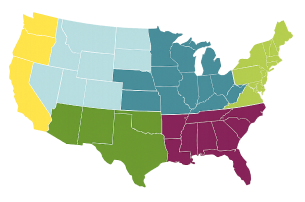How to Grow Bleeding Hearts
Posted By American Meadows Content Team on Mar 23, 2017 · Revised on Sep 5, 2025

Knowing your location helps us recommend plants that will thrive in your climate, based on your Growing Zone.
Posted By American Meadows Content Team on Mar 23, 2017 · Revised on Sep 5, 2025

Bleeding Hearts - delicate plants which faithfully return each spring to tell us that ’Winter has gone for good’
Plant Bleeding Hearts up close to the house, where you will be able to enjoy their exquisite flowers and ferny leaves each time you step outdoors.
And, for a mesmerizing woodland garden, grow more Bleeding Hearts in the shade of a group of spring-flowering trees like Serviceberries. Combining the Bleeding Hearts with some Lamium and Hostas will create a stunning textural carpet.

Light: Choose a spot, such as under a deciduous tree, that will provide full or partial shade throughout the summer. But avoid areas of truly deep shade, such as beneath a dense conifer.
Soil: Bleeding Hearts are woodland plants! So, in your garden, try to mimic their natural environment by enriching the soil with plenty of organic matter, preferably decayed leaves (leaf mold) or good compost. Also avoid areas where the soil will get excessively dry in the heat of summer (such as beneath a large Sugar Maple with very dense surface roots).
Spacing: Plant Fringed Bleeding Hearts, Fern-leaf Bleeding Hearts and Dutchman’s Breeches, between 12 and 15 inches apart. Plant Old Fashioned Bleeding Hearts, as well as its cultivar ‘Gold Hearts’, between 24 and 30 inches apart. However, position the white variety as well as the cultivar Valentine, (which do not grow quite as large) about 18 inches apart.
Planting: Plant the tubers in early spring or fall.
Loosen the soil to about a foot deep and incorporate plenty of organic matter. Plant the knobby roots (tubers) about an inch below the surface. Cover the soil with an inch or so of lightweight mulch— decayed leaves are ideal.
Growth habit: Fringed Bleeding Hearts, Fern-leaf Bleeding Hearts, the cultivar ‘Valentine’ and Dutchman’s Breeches all grow about twelve inches high and up to 18 inches wide. Old Fashioned Bleeding Hearts and the cultivar ‘Gold heart’ will grow about two feet high and up to 30 inches wide.
Staking: None needed.
Watering: Water your Bleeding Hearts weekly throughout their first season; this will help your new plants establish themselves in your garden. If you live where the summers are very hot and dry, water mature Bleeding Heart plants weekly. However, where the summers are cooler, mature Bleeding Hearts only need watering if you experience a prolonged dry spell.


Fertilizing: Soil enriched with plenty of organic matter will provide all the essential nutrients these woodland plants require.
Dead-heading/trimming: Dead-head the longer-blooming Fern-leaf and Fringed Bleeding Hearts during the summer to help promote new flowers and also to keep the plants looking neat and tidy as the season progresses.
Cut back the spent leaves at the end of the growing season, leaving an inch of the leaf stalks to protect the crown during the winter months.
To learn more about the plants we sell and how to grow them in your garden beds and patio containers, sign up for our inspiring emails.